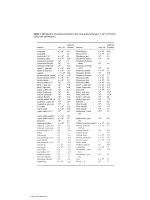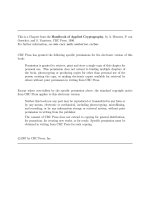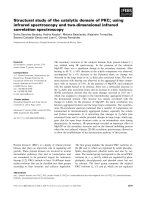Handbook of infrared spectroscopy of ultrathin films
Bạn đang xem bản rút gọn của tài liệu. Xem và tải ngay bản đầy đủ của tài liệu tại đây (6.29 MB, 739 trang )
www.pdfgrip.com
HANDBOOK OF
INFRARED
SPECTROSCOPY
OF ULTRATHIN FILMS
www.pdfgrip.com
www.pdfgrip.com
HANDBOOK OF
INFRARED
SPECTROSCOPY
OF ULTRATHIN FILMS
Valeri P. Tolstoy
Irina V. Chernyshova
Valeri A. Skryshevsky
A JOHN WILEY & SONS, INC., PUBLICATION
www.pdfgrip.com
Copyright 2003 by John Wiley & Sons, Inc. All rights reserved.
Published by John Wiley & Sons, Inc., Hoboken, New Jersey.
Published simultaneously in Canada.
No part of this publication may be reproduced, stored in a retrieval system, or transmitted in
any form or by any means, electronic, mechanical, photocopying, recording, scanning, or
otherwise, except as permitted under Section 107 or 108 of the 1976 United States Copyright
Act, without either the prior written permission of the Publisher, or authorization through
payment of the appropriate per-copy fee to the Copyright Clearance Center, Inc., 222
Rosewood Drive, Danvers, MA 01923, 978-750-8400, fax 978-750-4470, or on the web at
www.copyright.com. Requests to the Publisher for permission should be addressed to the
Permissions Department, John Wiley & Sons, Inc., 111 River Street, Hoboken, NJ 07030,
(201) 748-6011, fax (201) 748-6008, e-mail:
Limit of Liability/Disclaimer of Warranty: While the publisher and author have used their
best efforts in preparing this book, they make no representations or warranties with respect to
the accuracy or completeness of the contents of this book and specifically disclaim any
implied warranties of merchantability or fitness for a particular purpose. No warranty may be
created or extended by sales representatives or written sales materials. The advice and
strategies contained herein may not be suitable for your situation. You should consult with a
professional where appropriate. Neither the publisher nor author shall be liable for any loss
of profit or any other commercial damages, including but not limited to special, incidental,
consequential, or other damages.
For general information on our other products and services please contact our Customer Care
Department within the U.S. at 877-762-2974, outside the U.S. at 317-572-3993 or
fax 317-572-4002.
Wiley also publishes its books in a variety of electronic formats. Some content that appears
in print, however, may not be available in electronic format.
Library of Congress Cataloging-in-Publication Data:
Tolstoy, V. P. (Valeri P.)
Handbook of infrared spectroscopy of ultrathin films / V. P.
Tolstoy, I. V. Chernyshova, V. A. Skryshevsky.
p. cm.
ISBN 0-471-35404-X (alk. paper)
1. Thin films — Optical properties. 2. Infrared spectroscopy.
I. Chernyshova, I. V. (Irina V.) II. Skryshevsky, V. A. (Valeri
A.) III. Title.
QC176.84.07 T65 2003
621.3815 2 — dc21
2001007192
Printed in the United States of America
10 9 8 7 6 5 4 3 2 1
www.pdfgrip.com
CONTENTS
Preface
xiii
Acronyms and Symbols
xix
Introduction
xxv
1 Absorption and Reflection of Infrared Radiation by
Ultrathin Films
1
1.1.
Macroscopic Theory of Propagation of Electromagnetic
Waves in Infinite Medium / 2
1.2. Modeling Optical Properties of a Material / 10
1.3. Classical Dispersion Models of Absorption / 13
1.4. Propagation of IR Radiation through Planar Interface
between Two Isotropic Media / 24
1.4.1. Transparent Media / 26
1.4.2. General Case / 29
1.5. Reflection of Radiation at Planar Interface Covered by
Single Layer / 31
1.6. Transmission of Layer Located at Interface between Two
Isotropic Semi-infinite Media / 39
1.7. System of Plane–Parallel Layers: Matrix Method / 43
1.8. Energy Absorption in Layered Media / 49
1.8.1. External Reflection: Transparent Substrates / 50
1.8.2. External Reflection: Metallic Substrates / 52
1.8.3. ATR / 55
1.9. Effective Medium Theory / 60
1.10. Diffuse Reflection and Transmission / 65
Appendix / 68
References / 70
v
www.pdfgrip.com
vi
2
CONTENTS
Optimum Conditions for Recording Infrared Spectra of
Ultrathin Films
79
2.1. IR Transmission Spectra Obtained in Polarized
Radiation / 79
2.2. IRRAS Spectra of Layers on Metallic Surfaces
(“Metallic” IRRAS) / 84
2.3. IRRAS of Layers on Semiconductors and
Dielectrics / 87
2.3.1. Transparent and Weakly Absorbing Substrates
(“Transparent” IRRAS) / 87
2.3.2. Absorbing Substrates / 90
2.3.3. Buried Metal Layer Substrates
(BML-IRRAS) / 94
2.4. ATR Spectra / 100
2.5. IR Spectra of Layers Located at Interface / 102
2.5.1. Transmission / 102
2.5.2. Metallic IRRAS / 105
2.5.3. Transparent IRRAS / 110
2.5.4. ATR / 111
2.6. Choosing Appropriate IR Spectroscopic Method for
Layer on Flat Surface / 118
2.7. Coatings on Powders, Fibers, and Matte Surfaces / 120
2.7.1. Transmission / 120
2.7.2. Diffuse Transmittance and Diffuse
Reflectance / 122
2.7.3. ATR / 128
2.7.4. Comparison of IR Spectroscopic Methods for
Studying Ultrathin Films on Powders / 130
References / 133
3
Interpretation of IR Spectra of Ultrathin Films
3.1. Dependence of Transmission, ATR, and IRRAS Spectra of
Ultrathin Films on Polarization (Berreman Effect) / 141
3.2. Theory of Berreman Effect / 146
3.2.1. Surface Modes / 147
3.2.2. Modes in Ultrathin Films / 151
3.2.3. Identification of Berreman Effect in IR Spectra of
Ultrathin Films / 157
3.3. Optical Effect: Film Thickness, Angle of Incidence, and
Immersion / 159
140
www.pdfgrip.com
CONTENTS
3.3.1. Effect in “Metallic” IRRAS / 159
3.3.2. Effect in “Transparent” IRRAS / 164
3.3.3. Effect in ATR Spectra / 167
3.3.4. Effect in Transmission Spectra / 169
3.4. Optical Effect: Band Shapes in IRRAS as Function of Optical
Properties of Substrate / 171
3.5. Optical Property Gradients at Substrate–Layer Interface: Effect
on Band Intensities in IRRAS / 175
3.6. Dipole–Dipole Coupling / 179
3.7. Specific Features in Potential-Difference IR Spectra of
Electrode–Electrolyte Interfaces / 187
3.7.1. Absorption Due to Bulk Electrolyte / 189
3.7.2. (Re)organization of Electrolyte in DL / 190
3.7.3. Donation/Backdonation of Electrons / 202
3.7.4. Stark Effect / 202
3.7.5. Bipolar Bands / 203
3.7.6. Effect of Coadsorption / 205
3.7.7. Electronic Absorption / 206
3.7.8. Optical Effects / 210
3.8. Interpretation of Dynamic IR Spectra: Two-Dimensional
Correlation Analysis / 212
3.9. IR Spectra of Inhomogeneous Films and Films on Powders
and Rough Surfaces. Surface Enhancement / 219
3.9.1. Manifestation of Particle Shape in IR
Spectra / 220
3.9.2. Coated Particles / 223
3.9.3. Composite, Porous, and Discontinuous
Films / 225
3.9.4. Interpretation of IR Surface-Enhanced
Spectra / 232
3.9.5. Rough Surfaces / 241
3.10. Determination of Optical Constants of Isotropic Ultrathin
Films: Experimental Errors in Reflectivity
Measurements / 243
3.11. Determination of Molecular Packing and Orientation in
Ultrathin Films: Anisotropic Optical Constants of Ultrathin
Films / 252
3.11.1. Order–Disorder Transition / 253
3.11.2. Packing and Symmetry of Ultrathin Films / 257
3.11.3. Orientation / 266
3.11.4. Surface Selection Rule for Dielectrics / 280
3.11.5. Optimum Conditions for MO Studies / 282
References / 284
vii
www.pdfgrip.com
viii
4
CONTENTS
Equipment and Techniques
4.1. Techniques for Recording IR Spectra of Ultrathin Films on
Bulk Samples / 308
4.1.1. Transmission and Multiple Transmission / 308
4.1.2. IRRAS / 313
4.1.3. ATR / 317
4.1.4. DRIFTS / 327
4.2. Techniques for Ultrathin Films on Powders
and Fibers / 328
4.2.1. Transmission / 329
4.2.2. Diffuse Transmission / 331
4.2.3. Diffuse Reflectance / 334
4.2.4. ATR / 342
4.3. High-Resolution FTIR Microspectroscopy of Thin
Films / 343
4.3.1. Transmission / 345
4.3.2. IRRAS / 346
4.3.3. DRIFTS and DTIFTS / 347
4.3.4. ATR / 348
4.3.5. Spatial Resolution and Smallest Sampling
Area / 350
4.3.6. Comparison of µ-FTIR Methods / 351
4.4. Mapping, Imaging, and Photon Scanning Tunneling
Microscopy / 352
4.5. Temperature-and-Environment Programmed Chambers for In
Situ Studies of Ultrathin Films on Bulk and Powdered
Supports / 356
4.6. Technical Aspects of In Situ IR Spectroscopy of Ultrathin
Films at Solid–Liquid and Solid–Solid Interfaces / 360
4.6.1. Transmission / 361
4.6.2. In Situ IRRAS / 363
4.6.3. ATR / 369
4.6.4. Measurement Protocols for SEC
Experiments / 374
4.7. Polarization Modulation Spectroscopy / 376
4.8. IRRAS of Air–Water Interface / 381
4.9. Dynamic IR Spectroscopy / 383
4.9.1. Time Domain / 383
4.9.2. Frequency Domain: Potential-Modulation
Spectroscopy / 387
4.10. Preparation of Substrates / 389
4.10.1. Cleaning of IREs / 389
307
www.pdfgrip.com
CONTENTS
ix
4.10.2. Metal Electrode and SEIRA Surfaces / 391
4.10.3. BML Substrate / 393
References / 393
5 Infrared Spectroscopy of Thin Layers in Silicon
Microelectronics
416
5.1.
5.2.
5.3.
5.4.
Thermal SiO2 Layers / 416
Low-Temperature SiO2 Layers / 421
Ultrathin SiO2 Layers / 427
Silicon Nitride, Oxynitride, and Carbon Nitride
Layers / 434
5.5. Amorphous Hydrogenated Films / 439
5.5.1. a-Si:H Films / 439
5.5.2. a-SiGe:H / 444
5.5.3. a-SiC:H Films / 445
5.6. Films of Amorphous Carbon, Boron Nitride, and Boron
Carbide / 446
5.6.1. Diamondlike Carbon / 446
5.6.2. Boron Nitride and Carbide Films / 448
5.7. Porous Silicon Layers / 450
5.8. Other Dielectric Layers Used in Microelectronics / 454
5.8.1. CaF2 , BaF2 , and SrF2 Layers / 454
5.8.2. GeO2 Film / 456
5.8.3. Metal Silicides / 457
5.8.4. Amorphous Ta2 O5 Films / 458
5.8.5. SrTiO3 Film / 458
5.8.6. Metal Nitrides / 459
5.9. Multi- and Inhomogeneous Dielectric Layers: Layer-by-Layer
Etching / 460
References / 465
6 Application of Infrared Spectroscopy to Analysis of Interfaces
and Thin Dielectric Layers in Semiconductor Technology
6.1.
6.2.
Ultrathin Oxide Layers in Silicon Schottky-Type Solar
Cells / 476
Control of Thin Oxide Layers in Silicon MOS
Devices / 481
6.2.1. CVD Oxide Layers in Al – SiOx – Si
Devices / 482
6.2.2. Monitoring of Aluminum Corrosion Processes in
Al – PSG Interface / 484
476
www.pdfgrip.com
x
CONTENTS
6.2.3. Determination of Metal Film and Oxide Layer
Thicknesses in MOS Devices / 486
6.3. Modification of Oxides in Metal–Same-Metal Oxide–InP
Devices / 488
6.4. Dielectric Layers in Sandwiched Semiconductor
Structures / 492
6.4.1. Silicon-on-Insulator / 492
6.4.2. Polycrystalline Silicon–c-Si Interface / 493
6.4.3. SiO2 Films in Bonded Si Wafers / 494
6.4.4. Quantum Wells / 495
6.5. IR Spectroscopy of Surface States at SiO2 – Si
Interface / 497
6.6. In Situ Infrared Characterization of Si and SiO2
Surfaces / 502
6.6.1. Monitoring of CVD of SiO2 / 502
6.6.2. Cleaning and Etching of Si Surfaces / 504
6.6.3. Initial Stages of Oxidation of H-Terminated Si
Surface / 506
References / 508
7
Ultrathin Films at Gas–Solid, Gas–Liquid, and Solid–Liquid
Interfaces
7.1. IR Spectroscopic Study of Adsorption from Gaseous Phase:
Catalysis / 514
7.1.1. Adsorption on Powders / 515
7.1.2. Adsorption on Bulk Metals / 527
7.2. Native Oxides: Atmospheric Corrosion and Corrosion
Inhibition / 532
7.3. Adsorption on Flat Surfaces of Dielectrics and
Semiconductors / 542
7.4. Adsorption on Minerals: Comparison of Data Obtained
In Situ and Ex Situ / 547
7.4.1. Characterization of Mineral Surface after Grinding:
Adsorption of Inorganic Species / 547
7.4.2. Adsorption of Oleate on Calcium
Minerals / 551
7.4.3. Structure of Adsorbed Films of Long-Chain
Amines on Silicates / 554
7.4.4. Interaction of Xanthate with Sulfides / 561
514
www.pdfgrip.com
CONTENTS
xi
7.5.
Electrochemical Reactions at Semiconducting Electrodes:
Comparison of Different In Situ Techniques / 570
7.5.1. Anodic Oxidation of Semiconductors / 571
7.5.2. Anodic Reactions at Sulfide Electrodes in Presence of
Xanthate / 583
7.6. Static and Dynamic Studies of Metal Electrode–Electrolyte
Interface: Structure of Double Layer / 595
7.7. Thin Polymer Films, Polymer Surfaces, and
Polymer–Substrate Interface / 600
7.8. Interfacial Behavior of Biomolecules and Bacteria / 613
7.8.1. Adsorption of Proteins and Model Molecules at
Different Interfaces / 614
7.8.2. Membranes / 624
7.8.3. Adsorption of Biofilms / 626
References / 629
Appendix
References
Index
669
/ 687
691
www.pdfgrip.com
www.pdfgrip.com
PREFACE
In this book, we will designate ultrathin films, or, as they are also called in
the literature, nanolayers, to mean layers ranging from submonolayers to several
monolayers; these may be formed from a wide range of organic and inorganic
substances or present adsorbed atoms, molecules, biological species, on a substrate or at the interface of two media. These films play an important role in many
current areas of research in science and technology, such as submicroelectronics,
optoelectronics, optics, bioscience, flotation, materials science of catalysts, sorbents, pigments, protective and passivating coatings, and sensors. It could even be
argued that the rapid advances in thin-film technology has necessitated the development of special approaches in the synthesis and investigation of nanolayers and
superlattices. Nowadays, these approaches are generally applicable in so-called
nanotechnology, which includes the synthesis–deposition and characterization
of ultrathin films with a prescribed composition, morphology–architecture and
thicknesses on the order of 1 nm.
Common features in all studies in the field of nanotechnology arise from
problems connected with the physicochemical investigation of ultrathin films,
which originate in general from their extremely small thickness. To solve these
problems, a number of technically complicated physical methods that operate under UHV conditions, such as AES, XPS, LEED, HREELS are used.
Infrared (IR) spectroscopy and in particular Fourier transform IR (FTIR) spectroscopy — a method that enables the determination of molecular composition and
structure — offers important advantages in that the measurements can be carried
out for nanolayers located not only on a solid substrate but also at solid–gaseous,
solid–liquid, liquid–gaseous, and solid–solid interfaces, including semiconductor–semiconductor, semiconductor–dielectric, or semiconductor–metal, with no
destruction of either medium. Thus IR spectroscopy is one of a few physical
methods that can be used for both in situ studies of various processes on surface
and at interfaces and technological monitoring of thin-film structures in fields
such as microelectronics or optoelectronics under serial production conditions.
The versatility of modern FTIR spectroscopy provides means to characterize
ultrathin coatings on both oversized objects (e.g., works of art) and small (10–20µm) single particles, substrates with unusual shapes (e.g., electronic boards), and
recessed areas (e.g., internal surfaces of tubes). It should be emphasized that IR
xiii
www.pdfgrip.com
xiv
PREFACE
spectroscopy can be highly sensitive to ultrathin films: Depending on the system,
the sensitivity is 10−5 –10% monolayer.
However, the various IR spectroscopy techniques must be adapted to measure
spectra of very small amounts of substance in the form of ultrathin films. While
for analyses of bulk materials it is possible to select the optimum mass of substance to record its spectrum, in the case of ultrathin films it is only possible to
vary the conditions under which the spectra are recorded (measurement technique,
polarization, angle of incidence, immersion media, number of radiation passages
through the sample). For this purpose, it is necessary first to theoretically assess
the effect of the recording conditions on the intensity of the absorption bands.
By understanding optical theory for stratified media, it is also possible to
distinguish optical effects (artifacts), which present in each IR spectrum of an
ultrathin film, and, hence, to avoid misinterpretation of the experimental data.
Although the optimum conditions for a number of simple systems are known
(e.g., for ultrathin films on metals reflection–absorption (IRRAS) at grazing
angles of incidence is commonly used, and for ultrathin films on transparent
substrates, multiple internal reflection (MIR) is most suitable in many cases),
the spectral contrast can be further enhanced by employing additional special
technical approaches.
The material in this handbook is presented in such a way as to address these
issues. Thus, the theoretical concepts associated with the interaction of IR radiation with matter and with thin films are considered and, to evaluate the optimum
conditions routinely, simple algorithms for programming are given in Chapter 1.
In Chapter 2, a theoretical evaluation of the optimum conditions for measuring
nanolayer spectra is presented. In Chapter 3, a more detailed interpretation of the
IR spectra of ultrathin films on flat and powdered substrates is discussed from
the viewpoint of optical theory, including the authors’ methods of determination
of the optical constants of ultrathin films [1, 2] and molecular orientation [3]. In
Chapter 4, technical approaches to measure good-quality IR spectra of ultrathin
films are considered. Along with the techniques considered routine for studies
of ultrathin films in many laboratories and original techniques described in the
literature, techniques developed by the authors are included here, namely IR
spectroscopy of single and multiple transmission in p-polarized radiation [4, 5];
IRRAS of the surface of semiconductors and dielectrics [6]; IRRAS of metals,
semiconductors, and dielectrics in immersion media [7, 8]; diffuse transmission
of disperse materials [9, 10]; and the special attenuated total reflection (ATR)
technique for studying the semiconductor–solution interface [11]. An important feature of the optical accessories described is that they are placed in the
sample compartment of a conventional continuous-scan or step-scan FTIR spectrometer, without any change in the spectrometer optical scheme. In addition,
different attachments for specialized measurements are considered, including
IR microscope objectives, in situ chambers, and spectroelectrochemical cells.
Time-resolved spectroscopy and enhanced surface and structure sensitivity in IR
www.pdfgrip.com
PREFACE
xv
spectroscopic techniques such as modulation spectroscopy and two-dimensional
correlation analysis are described. Subsequent chapters illustrate some applications of these techniques in the study of thin-layer structures and semiconductor–electrolyte interfaces, which are currently of great practical significance
in electronics, solar energy storage, sensors, catalysis, bioscience, flotation, and
corrosion inhibition. Recommendations are given regarding application of these
techniques for automated and on-line analysis of thin-film structures. PAS [12,
13] are not included here, because its sensitivity is insufficient for the measurements in question. Infrared emission studies of ultrathin films have recently been
reviewed [14, 15]. Since this method, although rather surface sensitive under specific conditions, has not yet experienced extensive application, it is not considered
here as well. Instead, fundamentals and techniques of transmission, diffuse transmission, IRRAS, ATR, and DRIFTS methods will be presented, with emphasis
on their application to ultrathin films. Complementary information on how to use
these methods and their history may be found in other monographs [16–21].
It should be noted that because the material is presented in such a manner,
this monograph may serve as a handbook. It includes the theoretical foundations for the interaction of IR radiation with thin films, as well as the optimum
conditions of measuring spectra of various systems, which are analyzed by computer experiments and illustrated by specific examples. Complementary to this,
the basic literature devoted to the application of IR spectroscopy in the investigation of nanolayers of solids and interfaces is presented, and the necessary
reference material for the interpretation of spectra is tabulated. Thus this book
will be extremely useful for any laboratory employing IR spectroscopy, and for
each industrial firm involved in the production of thin-film structures, as well
as by final-year and postgraduate students specializing in the fields of optics,
spectroscopy, or semiconductor technology.
Dr. Valeri Tolstoy (St. Petersburg State University, Russia) authored Chapter 2
and Sections 3.5, 3.10, 4.1.1, 4.1.2, 4.2.1, 4.2.2, 4.4, 4.5, 7.1–7.3. Dr. Irina
Chernyshova (St. Petersburg State Polytechnical University, Russia) wrote
Chapters 1, 3, 4, and 7 (except for the sections mentioned above) and
coauthored Sections 2.3, 2.5, and 2.7. Prof. Valeri Skryshevsky (Kyiv National
Taras Shevchenko University, Ukraine) presents Chapters 5 and 6. Tables
in the Appendix were collected by Valeri Tolstoy and Irina Chernyshova.
The language and style were edited by Dr. Roberta Silerova (University of
Saskatchewan, Canada). Dr. Nadezhda Reutova (St. Petersburg State University,
Russia) translated into English Chapters 2, 5, and 6 and Sections 3.3–3.5, 3.10,
4.1, and 4.2, and helped with translation of Chapter 1 and Sections 3.1 and 3.2.
Acknowledgements
We thank Dr. Silerova for editing the English language, improving the handbook
style, and her great patience during the joint work several years long; Dr. Reutova
www.pdfgrip.com
xvi
PREFACE
for translating part of the text into English; and all the authors who have permitted citation of their results. VPT acknowledges a partial financial support
granted by Interfanional Scientific Foundation (USA), Russian Foundation for
Basic Research (RFBR), and Civilian Research and Development Foundation
(CRDF) (USA). IVC thanks RFBR, the Swedish Institute, and Elena Chernetskaya. VAS thanks Ministry of Ukraine for Education and Science. We all thank
friends and relatives who helped us with this work.
REFERENCES
1.
2.
3.
4.
5.
6.
7.
8.
9.
10.
11.
12.
13.
14.
15.
16.
17.
18.
19.
V. P. Tolstoy, G. N. Kusnetsova, and I. I. Shaganov, J. Appl. Spectrosc. 40, 978 (1984).
V. P. Tolstoy and S. N. Gruzinov, Opt. Spektrosc. 71, 129 (1991).
I. V. Chernyshova and K. Hanumantha Rao, J. Phys. Chem. B 105, 810 (2001).
V. P. Tolstoy, L. P. Bogdanova, and V. B. Aleskovski, Doklady AN USSR, 291, 913
(1986) (in Russian).
V. P. Tolstoy, A. I. Somsikov, and V. B. Aleskovski, USSR Inventor Certificate
No. 1099255, Byul. Izobr. 23, 145 (1984).
S. N. Gruzinov and V. P. Tolstoy, J. Appl. Spectrosc. 46, 480 (1987).
V. P. Tolstoy and V. N. Krylov, Opt. Spectrosc. 55, 647 (1983).
V. P. Tolstoy and S. N. Gruzinov, Opt. Spectrosc. 63, 489 (1987).
S. P. Shcherbakov, E. D. Kriveleva, V. P. Tolstoy, and A. I. Somsikov, Russ. J.
Equipment Tech. Exper. 1, 159 (1992).
V. P. Tolstoy and S. P. Shcherbakov, J. Appl. Spectrosc. 57, 577 (1992).
I. V. Chernyshova and V. P. Tolstoy, Appl. Spectrosc. 49, 665 (1995).
J. F. McClelland, R. W. Jones, S. Luo, and L. M. Seaverson, in P. B. Coleman (Ed.),
Practical Sampling Techniques for Infrared Analysis, CRC Press, Boca Raton, FL,
1993, Chapter 5.
J. F. McClelland, S. J. Bajic, R. W. Jones, and L. M. Seaverson, in F. M. Mirabella
(Ed.), Modern Techniques in Applied Molecular Spectroscopy, Wiley, New York,
1998, Chapter 6.
W. Suetaka, Surface Infrared and Raman Spectroscopy. Methods and Applications,
Plenum, New York, 1995, Chapter 4.
S. Zhang, F. S. Franke, and T. M. Niemczyk, in F. M. Mirabella (Ed.), Modern
Techniques in Applied Molecular Spectroscopy, Wiley, New York, 1998, Chapter 9.
F. M. Mirabella (Ed.), Modern Techniques in Applied Molecular Spectroscopy, Wiley,
New York, 1998.
W. Suetaka, Surface Infrared and Raman Spectroscopy. Methods and Applications,
Plenum, New York, 1995.
F. Mirabella (Ed.), Internal Reflection Spectroscopy, Marcel Dekker, New York, 1993.
P. B. Coleman, Practical Sampling Techniques for Infrared Analysis, CRC Press,
Boca Raton, FL, 1993.
www.pdfgrip.com
PREFACE
xvii
20. J. Workman, Jr. and A. W. Springsteen (Eds.), Applied Spectroscopy: A Compact
Reference for Practitioners, Academic, San Diego, 1998.
21. J. Chalmers and P. Griffiths (Eds.), Handbook of Vibrational Spectroscopy, Vol. 1,
Wiley, New York, 2002, Chapter 1.
VALERI TOLSTOY
IRINA CHERNYSHOVA
VALERI SKRYSHEVSKY
www.pdfgrip.com
www.pdfgrip.com
ACRONYMS AND SYMBOLS
A/D
AES
AFM
ARUPS
ATR
AU
AW
BF
bi CMOS
BLB
BM
BML
BP
CMC
CMLL
CMP
CS
CVD
DA
DAC
DCT
DF
DL
DMA
DR
DR
DRIFTS
DT
DTA
DTGS
DTIFTS
analog–digital (convertor)
Auger electron spectroscopy
atomic force microscopy
angle-resolved UV photoelectron spectroscopy
attenuated total reflection
arbitrary units
air–water (interface)
Bruggeman formula
bipolar and complementary MOS
Bouguer–Lambert–Beer (law)
Bruggeman model
buried metal layer
bandpass
critical micelle concentration
Clausius–Mossotti/Lorentz–Lorenz (model)
chemomechanical polishing
compressed solid (L monolayer phase)
chemical vapor deposition
Drude absorption, dispersion analysis
diamond anvil cell
dielectric continuum theory
distribution function
double layer
dynamic mechanical analysis
diffuse reflection
dichroic ratio
diffuse reflectance infrared Fourier transform
spectroscopy
diffuse transmission
differential thermal analysis
deuterated triglicine sulfate (detector)
diffuse transmittance infrared Fourier transform
spectroscopy
xix
www.pdfgrip.com
xx
ACRONYMS AND SYMBOLS
EDS
EELS
EFA
EIRE
EMIRS
EMT
ERS
EWAS
EXAFS
FET
FPA
FTEMIRS
µ-FTIR
FTIR
FWHM
GIR
GIXD
H/D
HATR
HL
HM
HP
HPLC
HREELS
IC
ILD
IOW
IP
IR
IRE
IRRAS
ITO
KK
KM
L monolayer
LB film
LC
LE
LED
LEED
LIA
LO
LP
LPD
LST
energy dispersive X-ray spectroscopy
electron energy loss spectroscopy
electric field analysis
extended internal reflection element
electrochemically modulated infrared spectroscopy
effective medium theory
external reflection spectroscopy
evanescent wave absorption spectroscopy
extended X-ray absorption fine-structure
field-effect transistor
focal plane array
Fourier transform EMIRS
Fourier transform infrared microscopy
Fourier transform infrared spectroscopy
full width at half maximum
grazing internal reflection
grazing-incidence X-ray diffraction
hydrogen/deuterium (exchange)
horizontal ATR
Helmholtz layer
hemimicelle model
highpass
high performance liquid chromatography
high resolution electron energy loss spectroscopy
integrated circuit
infrared linear dichroism
integrated optical waveguide
in-phase
infrared
internal reflection element
infrared reflection absorption spectroscopy
indium tin oxide
KramersKrăonig
KubelkaMunk
Langmuir monolayer
LangmuirBlodgett lm
liquid condensed (L monolayer phase)
liquid expanded (L monolayer phase)
light-emitting data
low-energy electron diffraction
lock-in-amplifier
longitudinal optical
lowpass
liquid-phase deposition
Lyddane–Sachs–Teller (law)
www.pdfgrip.com
ACRONYMS AND SYMBOLS
LT-OTTE
LUMO
MAS NMR
MBE
MCT
MG
MGEMT
MIR
MIRE
MIS
MIT
ML
MO
MOATR
MOS
MOSFET
MP
MSEF
MTC
NEXAFS
NIR
NMR
NMSEF
OCP
ODT
OTE
OTTLE
PAS
PCA
PDIR
PECVD
PEDR
PEM
PET
PFPE
PM
PMMA
PSTM
PTFE
PVA
PVC
PVD
Q
QCM
RA
low-temperature OTTE
lowest unoccupied molecular orbital
magic angle spinning NMR
molecular beam epitaxy
mercury-cadmium-tellurium
Maxwell–Garnett (dielectric function)
Maxwell–Garnett effective medium theory
multiple internal reflection
multireflection internal reflection element
metal insulator semiconductor
multiple internal transition
monolayer
molecular orientation
metal-overlayer ATR
metal–oxide–semiconductor
metal–oxide–semiconductor FET
monolayer packing
mean-square electric field
monothiocarbonate
near-edge X-ray absorption fine structure
near IR
nuclear magnetic resonance
normalized mean-square electric field
open-circuit potential
order–disorder transition
optically transparent electrode
optically transparent thin-layer electrochemical (cell)
photoacoustic spectroscopy
principal component analysis
potential-difference infrared (spectroscopy)
plasma enhanced vapor deposition
Perkin–Elmer diffuse reflectance
photoelestic modulator
poly(ethylene teriphtalate)
perfluoropolyesther
polarization modulation
poly(methyl methacrylate)
photon STM
poly(tetrafluoroethylene)
poly(vinyl acetate)
poly(vinyl chloride)
physical vapor deposition
quadrature
quartz crystal microbalance
reflectance-absorbance
xxi
www.pdfgrip.com
xxii
ACRONYMS AND SYMBOLS
RBS
RH
RTPM
S2
SAM
SAW
SCE
SCR
SE
SEC
SEIRA
SEM
SERS
SEW
SFG
SHE
SHG
SI
SIA
SIMOX
SIMS
SIPOS
SNIFTIRS
SNOM
SNR
SOI
SPAIRS
SPR
SSR
STIRS
STM
STPD
TDM
TEM
TG
TIRF
TLC
TMOS
TO
TPD
TR
UHV
ULSC
ULSI
UV
Rutherford backscattering
relative humidity
real-time PM
step-scan
self-assembled monolayer
surface acoustic wave
saturated calomel electrode
space charge region
semiconductor electrode
spectroelectrochemical
surface enhanced infrared absorption
scanning electron microscopy
surface enhanced Raman spectroscopy
surface electromagnetic waves
sum frequency generation
standard hydrogen electrode
second harmonic generation
international system of units
sequential implantation and annealing
separation by implanted oxygen
secondary ion mass spectrometry
semi-insulating polycrystalline silicon
subtractively normalized interfacial FTIR spectroscopy
scanning near field optical microscopy
signal-to-noise ratio
silicon-on-insulator
single potential alternation IR spectroscopy
surface plasmon resonance
surface selection rule
surface titration by internal reflectance spectroscopy
scanning tunneling microscopy
stepwise thermo-programmed desorption
transitional dipole moment
transmission electron spectroscopy
thermogravimetry
total internal reflection fluorescence
thin layer chromatography
tetraethylorthosilicate
transverse optical
temperature programmed desorption
time resolution
ultra high vacuum
ultra large scale circuit
ultra large scale integrated
ultraviolet (radiation)
www.pdfgrip.com
ACRONYMS AND SYMBOLS
VLSI
VPE
WAXS
X, EX, BX, AX
XANES
XPS
2D IR
very large scale integrated
vapor phase epitaxy
wide-angle X-ray scattering
xanthate (ethyl-, n-butyl-, amyl-)
X-ray absorption near-edge structure
X-ray photoelectron spectroscopy
two dimensional correlation analysis of IR dynamic
spectra
Symbols
αˆ
α
β
γ
δ
ε
ε∞
εm
εsm
εst
θ
λ
µ
ν
ρ
ρ
σ
τ
ϕ1 or ϕ
ω
ωp
A
B
c
C
d
D
dp
E
E
Eg
E
f
gk
Electric polarizability
Decay constant≡absorption coefficient
Restoring force
Tilt angle, damping constant
Bending mode
Permittivity≡dielectric constant≡dielectric function
High-frequency dielectric constant≡screening factor
Permittivity of metal
Permittivity of surrounding medium
Static (low-frequency) dielectric constant
Angle of bond
Wavelength
Permeability
Wavenumber, Stretching mode
Mass volume density, resistivity, rocking mode
Dynamic dipole moment
Electrical conductivity
Time
Angle of incidence
Wagging mode, angular velocity
Plasma frequency
Absorbance
Magnetic induction
Velocity of light
Volume/mass concentration
Thickness
Electric displacement
Penetration depth
Electric field
Electrode potential, electric field
Energy gap
Integrated molar absorption coefficient
Filling fraction
Geometric factor
xxiii
www.pdfgrip.com
xxiv
h
H
I
j
k
k
m
M
N
n
p
P
r
R
S
t
T
v
ACRONYMS AND SYMBOLS
Plank constant
Magnetic field
Intensity of radiation
Current density
Extinction coefficient≡absorption index
Wave vector
Mass
Magnetic polarization
Surface or volume density of molecules (atoms), number
of reflections
Refractive index
Dipole moment
Electric polarization
Reflection coefficient
Reflectance
Oscillator strength
Time/transmission coefficient
Temperature/transmittance
Velocity









